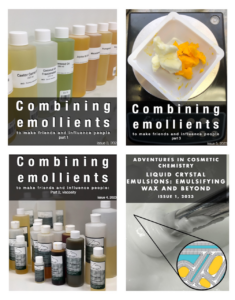Welcome to the series, combining emollients. You can find all the links for the series and the e-books!
- Links to the e-books!
- Some posts that'll be helpful for this series…
- PART ONE: Introduction
- PART TWO: Spreadability and spreading values
- PART THREE: Liquid & solid emollients, and the impact of saturation
- PART FOUR: Viscosity
- PART FIVE: Surface tension
- PART SIX: Viscosity and surface tension
- PART SEVEN: Interfacial tension and molecular shape, size, and weight!
- PART EIGHT: Putting it all together and spreading values!
- PART NINE: Part nine, let’s take a look at some emollients!
Links to the e-books!

Combining emollients to win friends and influence people, part one
Combining emollients to win friends and influence people, part two
Combining emollients to win friends and influence people, part three
Some posts that’ll be helpful for this series…
This post will be helpful – Defining some cosmetic chemistry terms: Spreadability, play time, cushion, drag, slip & glide, and melt point – if you aren’t familiar with some of the sensory characteristic terms.
And this download will be helpful – Blank sensory comparison chart – a blank sheet where you can record your sensory experiences with emollients.
Here’s the rest of that series, found in this section of the blog…
Defining some scientific terms: Solubility, viscosity, surface tension, and interfaces
Defining some scientific terms: Contact angle, wetting, refractive index, and specific gravity
Defining some cosmetic chemistry terms: Spreadability, play time, cushion, drag, and melt point
PART ONE: Introduction
Introduction to the concept of combining emollients to create interesting sensory experiences
PART TWO: Spreadability and spreading values
Spreadability & spreading values
Combining emollients: Spreading values – Let’s create a lotion (part one)!
Combining emollients: Spreading values – Let’s create a lotion (part three) – formula with esters
Combining emollients: Emulsifiers – Simulsol/Lotionpro™ 165 – part one
Combining emollients: Emulsifiers – Simulsol/Lotionpro™ 165 – part two
PART THREE: Liquid & solid emollients, and the impact of saturation
Liquid and solid emollients, and the impact of saturation
Liquid & solid emollients: Part one, what can we learn from iodine values?
Liquid & solid emollients: Part two, predicting sensory characteristics of a lotion
Liquid & solid emollients: Part three, applying what we’ve learned to a naturally compliant emulsion
Liquid & solid emollients: Part four, creating a cold process, 10 minute lotion
PART FOUR: Viscosity
Part four: Spreading values and viscosity – let’s review!
Creating an anhydrous body oil (part one, reviewing what we know)
Creating an anhydrous body oil (part two, choosing emollients)
Creating an anhydrous body oil (part three, creating a formula)
Creating an anhydrous body oil (part four, meeting some oil soluble extracts)
Creating an anhydrous body oil (part five, using oil soluble extracts)
Review & cheat sheet of what we’ve learned so far in this series…
PART FIVE: Surface tension
Introduction to surface tension! (coming December 26, 2020)
PART SIX: Viscosity and surface tension
Part one, introduction to the concept (coming December 27, 2020)
Part two, the worksheet! (coming December 28, 2020)
PART SEVEN: Interfacial tension and molecular shape, size, and weight!
Part one, interfacial tension and polarity
Part two, molecular structure, shape, size, and weight
PART EIGHT: Putting it all together and spreading values!
Part one, putting it all together with some review of specific emollients!
Review of the entire series with printable PDF
